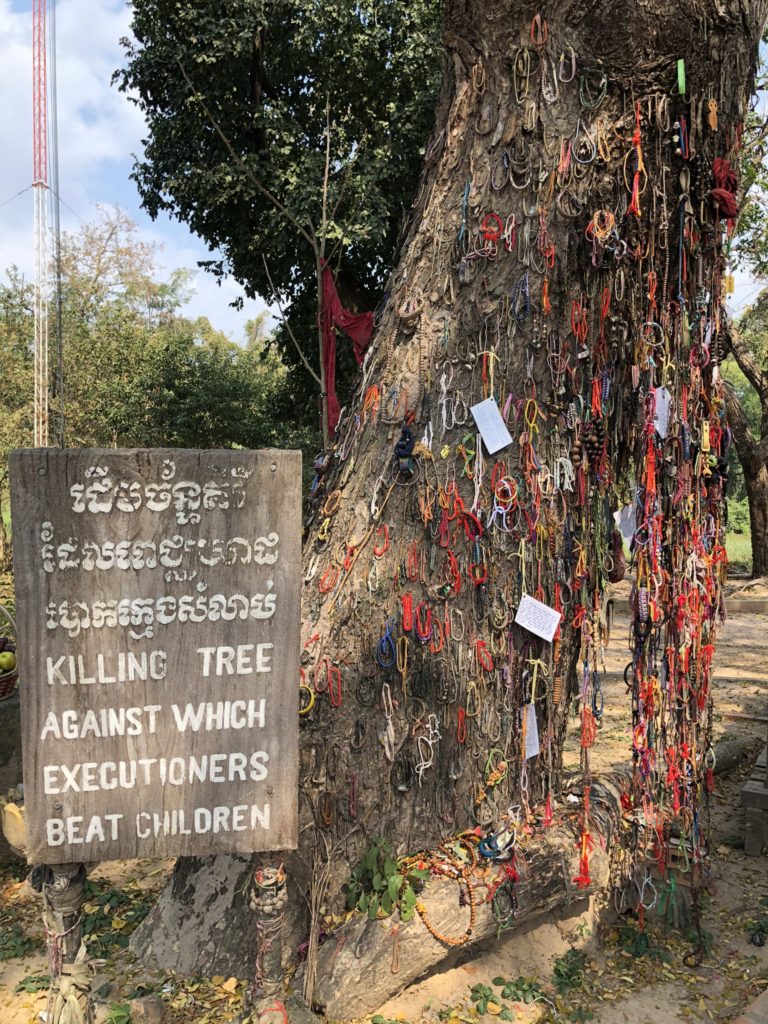Writing this post from the busy lobby of the Envoy Hotel lobby. Classic hostel; dorm beds are $6/night, excellent WiFi, great breakfasts with passionfruit smoothies. It’s hard not to eavesdrop on all of the conversations, mostly people in their twenties, talking about where they’ve been and where they’re going, what they’re doing with their lives. The hostel takes dollars, as does everything else I have purchased here; I keep asking about changing money, but people tell me not to worry about it.
We arrived here at 11 AM yesterday. Happily, we could not check in until 2 pm, so Declan could not argue too much about going to the Killing Fields and the genocide museum. He grumbled about going, but he listened with interest to every stop on the audio tour. The audio tour was really great, narrated in various languages by Cambodians, often Cambodian survivors of the Khmer Rouge.
From 1975 to 1979, the Khmer Rouge killed approximately two or three million people, about 25% of the population of Cambodia. Pol Pot wanted to establish a kind of communism where everyone was equal, celebrating an agrarian past but eschewing modern farming equipment. People who were suspected of having an education were executed: wearing eyeglasses, having soft hands, speaking another language, possessing books, could all lead to execution on suspicion of being educated. The tower of skulls was very sobering. Forensic experts had examined the skulls; many were adorned by color-coded dots: “killed by machete”, “killed by chemicals”, “killed by hoe”. The damaged skulls bore testimony to the violence of the deaths.
In one corner of the Choueng Ek Genocidal Center (killing fields) was the “executioner’s tree.” Small children were killed by having their skulls beaten against the tree; their bodies were later thrown in a mass grave. Children’s clothes were visible in the piles of clothing collected from victims; it is hard to imagine the execution of small children, but apparently, it was part of Pol Pot’s approach to rid Angka (“the organization”) of evil, starting at the (family) root.
Both the genocide museum and the killing fields were very moving. All fo the visitors were walking around listening to their audio guides in various languages, which created an atmosphere of respectful silence. Everyone was in their own little world, listening to the horrors that had taken place.
It was a somber afternoon, but I wanted to start to understand what happened under Pol Pot’s Khmer Rouge. Declan and I will go rock climbing in Kampot and volunteer at an elephant sanctuary in Mondulkiri, but the Khmer Rouge legacy is deeply woven into Cambodia. I look at older people and wonder how they survived the Khmer Rouge; I wonder what stories the younger people have heard from their parents and grandparents.
This morning I woke up at 5:45 to take a sunrise walk around some of the monuments and temples. Just another sign that I chose the wrong accommodation; our roommates in our six-person dorm room got home at 3:15! They were still asleep when we checked out.
Beautiful morning light and very little traffic; people of all ages exercising in the park. Below is a photo of the Independence Monument, as well as the Cambodian flag, emblazoned with a depiction of Angkor Wat. I looked up the history of
Off to Kampot…












Julie
We wish someone had posted the bathroom sign in China when we were there in 1988.
Cambodia sounds intriguing and incredibly sad!! Love hearing all of your insights!
Susan
I loved thinking about various overweight Americans trying to get into the forbidden squatting position!
very interesting, tragic
Comments are closed.